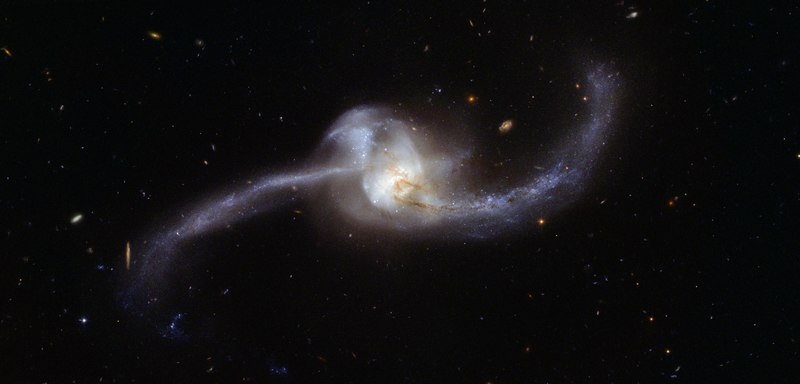Datei:NGC 2623 or Arp 243 - HST Potw1742a.tif

Originaldatei (3.978 × 1.910 Pixel, Dateigröße: 17,72 MB, MIME-Typ: image/tiff)
Diese Datei stammt aus Wikimedia Commons und kann von anderen Projekten verwendet werden. Die Beschreibung von deren Dateibeschreibungsseite wird unten angezeigt.
Beschreibung
| BeschreibungNGC 2623 or Arp 243 - HST Potw1742a.tif |
English: A glimpse of the future
This image, captured by the NASA/ESA Hubble Space Telescope, shows what happens when two galaxies become one. The twisted cosmic knot seen here is NGC 2623 — or Arp 243 — and is located about 250 million light-years away in the constellation of Cancer (The Crab). NGC 2623 gained its unusual and distinctive shape as the result of a major collision and subsequent merger between two separate galaxies. This violent encounter caused clouds of gas within the two galaxies to become compressed and stirred up, in turn triggering a sharp spike of star formation. This active star formation is marked by speckled patches of bright blue; these can be seen clustered both in the centre and along the trails of dust and gas forming NGC 2623’s sweeping curves (known as tidal tails). These tails extend for roughly 50 000 light-years from end to end. Many young, hot, newborn stars form in bright stellar clusters — at least 170 such clusters are known to exist within NGC 2623. NGC 2623 is in a late stage of merging. It is thought that the Milky Way will eventually resemble NGC 2623 when it collides with our neighbouring galaxy, the Andromeda Galaxy, in four billion years time. In contrast to the image of NGC 2623 released in 2009 (heic0912), this new version contains data from recent narrow-band and infrared observations that make more features of the galaxy visible.
Coordinates Position (RA): 8 38 23.99 Position (Dec): 25° 45' 19.27" Field of view: 3.32 x 1.59 arcminutes Orientation: North is 134.8° right of vertical Colours & filters Band Wavelength Telescope Optical B 435 nm Hubble Space Telescope ACS Optical V 555 nm Hubble Space Telescope ACS Optical I 814 nm Hubble Space Telescope ACS Optical H-alpha 656 nm Hubble Space Telescope WFC3 Optical H-Alpha + NII 665 nm Hubble Space Telescope WFC3 Infrared J 1.1 μm Hubble Space Telescope WFC3. |
| Datum | 16 October 2017, 06:00 (release) |
| Quelle | https://www.spacetelescope.org/images/potw1742a/ |
| Urheber | Credit: ESA/Hubble & NASA |
Lizenz
| ESA/Hubble images, videos and web texts are released by the ESA under the Creative Commons Attribution 4.0 International license and may on a non-exclusive basis be reproduced without fee provided they are clearly and visibly credited. Detailed conditions are below; see the ESA copyright statement for full information. For images created by NASA or on the hubblesite.org website, or for ESA/Hubble images on the esahubble.org site before 2009, use the {{PD-Hubble}} tag.
Conditions:
Notes:
|
- Dieses Werk darf von dir
- verbreitet werden – vervielfältigt, verbreitet und öffentlich zugänglich gemacht werden
- neu zusammengestellt werden – abgewandelt und bearbeitet werden
- Zu den folgenden Bedingungen:
- Namensnennung – Du musst angemessene Urheber- und Rechteangaben machen, einen Link zur Lizenz beifügen und angeben, ob Änderungen vorgenommen wurden. Diese Angaben dürfen in jeder angemessenen Art und Weise gemacht werden, allerdings nicht so, dass der Eindruck entsteht, der Lizenzgeber unterstütze gerade dich oder deine Nutzung besonders.
Kurzbeschreibungen
In dieser Datei abgebildete Objekte
Motiv
Dateiversionen
Klicke auf einen Zeitpunkt, um diese Version zu laden.
| Version vom | Vorschaubild | Maße | Benutzer | Kommentar | |
|---|---|---|---|---|---|
| aktuell | 05:00, 16. Okt. 2017 |  | 3.978 × 1.910 (17,72 MB) | wikimediacommons>Fabian RRRR | =={{int:filedesc}}== {{Information |description={{en|1='''A glimpse of the future This image, captured by the NASA/ESA Hubble Space Telescope, shows what happens when two galaxies become one. The twisted cosmic knot seen here is NGC 2623 — or Arp 24... |
Dateiverwendung
Die folgende Seite verwendet diese Datei:
Metadaten
Diese Datei enthält weitere Informationen, die in der Regel von der Digitalkamera oder dem verwendeten Scanner stammen. Durch nachträgliche Bearbeitung der Originaldatei können einige Details verändert worden sein.
| page_data |
|
|---|---|
| page_count | 1 |
| first_page | 1 |
| last_page | 1 |
| exif |
|
| tiff_metadata_version | 1,4 |

